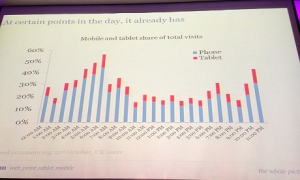Although mobile has been coming on strong as a primary means of computing, it still lags overall desktop internet usage. But for some publishers who started on the web, there are already moments during the week when mobile drives the majority of traffic or sales.

The Guardian’s traffic by hour
The Guardian’s Anthony Sullivan, group product manager for Guardian Core products at Guardian News & Media, said Monday that mobile — both smartphones and tablets — now contributes about 35 percent of traffic overall. That’s up from 10 percent at the start of 2011, when it was primarily smartphone traffic. (See disclosure below)
But at 6 a.m. to 7 a.m. in the morning local time, the Guardian gets more traffic from mobile devices. It also sees more mobile visitors than desktop visitors on Saturdays at 3 p.m. when the Premier League is under way.
Meanwhile, online design store Fab.com said late last month that on Saturdays between 12:00 a.m. and 6 a.m. local time, it sees 53 percent of its sales from mobile devices. On recent weekends, sales from mobile devices are now up to 40 percent, with weekend mornings before noon leading the way. Saturday evenings are also very popular with mobile users, with 44 percent of users buying on mobile devices between 6 p.m. and midnight.
The numbers are still early and these two properties are pretty popular with mobile users. Sullivan said in a Guardian story that the tipping point in favor of mobile might still be two years away. Fab’s CEO and co-founder Jason Goldberg, however, said based on the fast growth of mobile sales, he believes that Fab will see more parts of the day in which traffic from mobile devices goes over 50 percent in the coming months. And he said mobile will contribute more sales than desktop on certain days “soon.” Currently, 33 percent of Fab’s sales come from mobile devices.
The numbers underscore why mobile is so powerful. And it highlights the continuous nature of computing these days. The reality is today we are constantly on some type of computer throughout the day, moving back and forth between devices for different tasks and different settings. Mobile devices fill in the times when reaching for a laptop or desktop is more difficult, including early mornings, during lunch, as we settle in for the night and during the weekends.

Fab’s sales broken down by day parts
That’s the case with me. My first 15-30 minutes in the morning are spent looking at tweets, emails and websites from bed on my smartphone before heading over to my laptop. My day is largely spent on my laptop except during lunch. And then at night I switch back over to mobile devices primarily. On the weekends, I’m on my iPad and smartphone unless work arises.
Flurry recently found that mobile app usage peaked at 9 p.m. at night and was strongest overall between 7 and 11 p.m. But it apps had higher usage throughout the day compared to Internet usage and TV viewing except in primetime, when TV viewing was greater.
The traditional computer will still have a place but we’re increasingly fulfilling the picture Steve Jobs painted a couple years ago. PCs, he said, are going to be more like trucks, taking on bigger computing tasks while we get more and more done on nimble car-like mobile devices. We’ll still need a decent computer for work, heavier research and content creation. But the rest of our expanding computing time is going to be filled with mobile devices.
Disclosure: Guardian News and Media Ltd., the parent company of the Guardian newspaper, is an investor in the parent company of this blog, Giga Omni Media.
Photo courtesy of Flickr user Ben Dodson.
![]()
![]()

